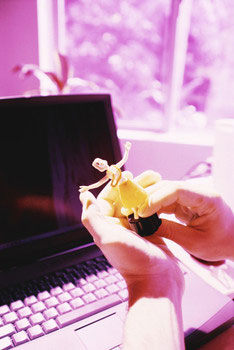
| HOME | GRAPHIC DESIGN | DESKTOP PUBLISHING | RESOURCES | DIRECTORY | SITE MAP |
An appetite for design
Each student had to supply a recipe for the cookbook, as well as a supporting illustration on a two-page layout. Custom Printers advised us that each printed page was to measure 4 1/2" x 5 1/2" and also recommended allowing space for spiral binding for more effective kitchen use. In class we reviewed an article in the Spring 1998 issue of Adobe Magazine titled Food for Thought (go to www.adobe.com/products/adobemag/archive/spr98na.html) that discussed cookbooks and contemporary design, the handling of fractions in desktop publishing and the emergence of "expert typefaces." We also covered the resurgence of old-style numerals now being distributed by many digital foundries and how they allow for more even "color" in text setting. We studied several interesting ways that contemporary designers are looking at the printed page. We reviewed layouts in Emigre, Raygun (out of print, unfortunately, but old copies do exist--check online) and Rolling Stone magazines and observed how many of these seemingly eccentric layered typographic and layout solutions had now made their way into mainstream advertising campaigns. After pencil roughs, students composed the typographic component of their layouts directly on the computer screen using QuarkXPress[TM]. Students were encouraged to use a variety of fonts, as well as experimental leading and angling of text. Each illustration required its own creative solution. Some students elected to draw images directly in Photoshop[R], while others took a more traditional route and rendered their creations using a variety of media and then scanned them. Still others created images using the polygon and blending tools in and the more adventurous used Adobe[R] Illustrator[R] All images were imported into Quark and re-sized and in some cases re-scaled to fit the layout concerned. The results are impressive. Among my favorites is Ross Machon's clever "Spaghetti Sandwich" layout, which used a scanned image of his own handwriting and a digital image of an actual spaghetti sandwich captured on an Apple Quicktake 200 camera, downloaded directly to our Macintosh computer and tweaked in Photoshop. Trevor Kopf-Johnson assures readers that his dad's "Flower Pot Bread" is a great recipe, but emphasizes that the flower pot must be prepared properly as per instructions on his dynamic layout. Karen Dickson of Custom Printers of Renfrew contributed her "Chocolate Chip Coffee Cake" recipe to the book and was kind enough to bake a cake and send it to the class, where my students were only too happy to sample and pronounce the cake and the recipe award-winning. The students took photographs of Mark (Custom Printer's amicable driver and goodwill ambassador) and the cake, and married both images in Photoshop in a creative collage that is a highlight of the book. Each student worked on his or her recipe and after laser-printed proofs were approved, downloaded their Quark file and accompanying illustrations via internal e-mail to a special cookbook assignment folder on the art department files in the school server. Tony MacDonell, a former student who has just completed his first year at Algonquin College's Graphic Design faculty, created the cover and collated all the student files into one master Quark document that was delivered on disk with a mock-up to our friends at Custom Printers. After clearing a few electronic glitches, the cookbook was printed, bound and ready for distribution at our school's annual art show. This kind of exercise is a fitting way to end senior-high-school design studies at the secondary level. This project required students to take the instruction they had received in typography, image processing, desktop publishing and traditional media, and apply it to an actual commercial job. They had to deal with the same design criteria and pitfalls that a working commercial artist would have to deal with on a day-to-day basis. At the time he wrote this article, Irv Osterer was the art-department head at Confederation High School in Nepean, Ontario, Canada. Currently, he is head of Fine Arts, Library and Technology at Merivale High School, also in Nepean. |
Copyright 2026 Sxkp.net All rights reserved.
|
 Everyone has a favorite cookbook. Book vendors report that recipe books, specialty food books and magazines are still great sellers in these hi-tech, low-touch times. After seeing the wide variety in our local bookstore, I thought that a cookbook would be a fitting project for my senior information-design students. I also thought it would be a great promotional vehicle for my good friends at Custom Printers of Renfrew, who participate annually in a group project with my senior information-design class.
Everyone has a favorite cookbook. Book vendors report that recipe books, specialty food books and magazines are still great sellers in these hi-tech, low-touch times. After seeing the wide variety in our local bookstore, I thought that a cookbook would be a fitting project for my senior information-design students. I also thought it would be a great promotional vehicle for my good friends at Custom Printers of Renfrew, who participate annually in a group project with my senior information-design class.